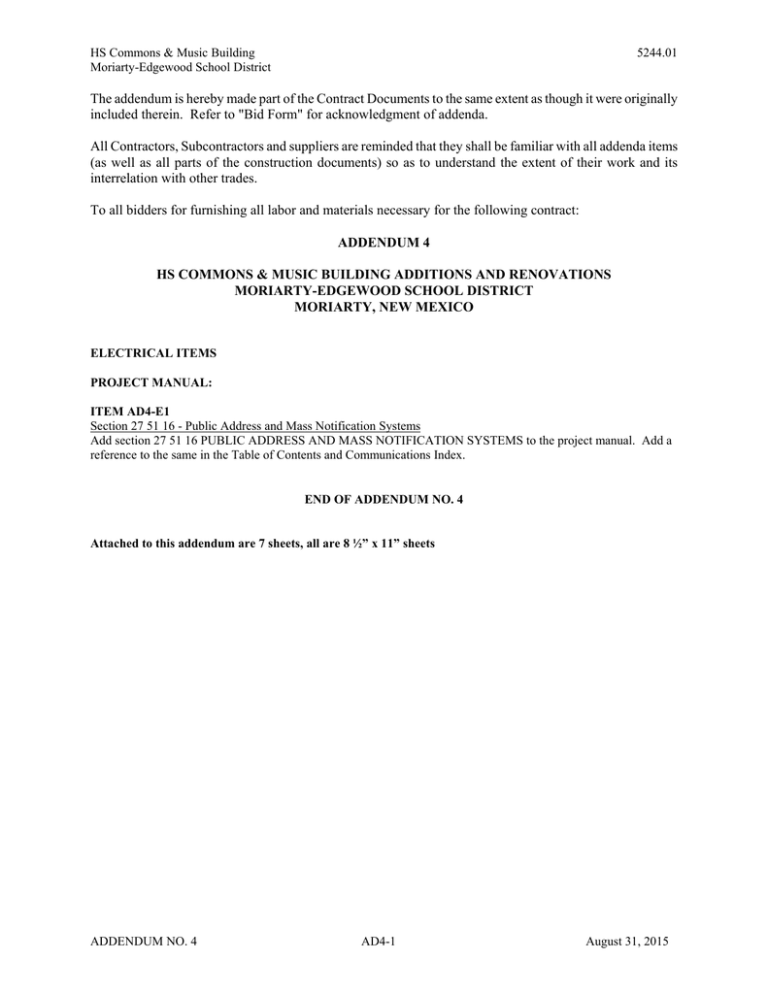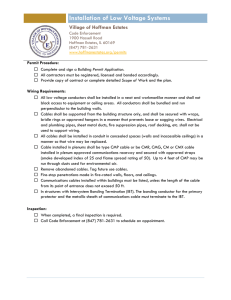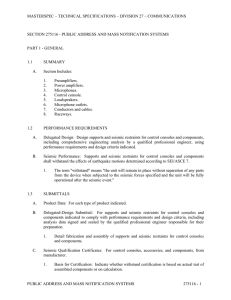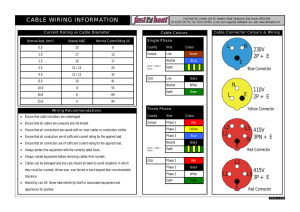Addendum 4 - Pavilion Construction
advertisement

HS Commons & Music Building Moriarty-Edgewood School District 5244.01 The addendum is hereby made part of the Contract Documents to the same extent as though it were originally included therein. Refer to "Bid Form" for acknowledgment of addenda. All Contractors, Subcontractors and suppliers are reminded that they shall be familiar with all addenda items (as well as all parts of the construction documents) so as to understand the extent of their work and its interrelation with other trades. To all bidders for furnishing all labor and materials necessary for the following contract: ADDENDUM 4 HS COMMONS & MUSIC BUILDING ADDITIONS AND RENOVATIONS MORIARTY-EDGEWOOD SCHOOL DISTRICT MORIARTY, NEW MEXICO ELECTRICAL ITEMS PROJECT MANUAL: ITEM AD4-E1 Section 27 51 16 - Public Address and Mass Notification Systems Add section 27 51 16 PUBLIC ADDRESS AND MASS NOTIFICATION SYSTEMS to the project manual. Add a reference to the same in the Table of Contents and Communications Index. END OF ADDENDUM NO. 4 Attached to this addendum are 7 sheets, all are 8 ½” x 11” sheets ADDENDUM NO. 4 AD4-1 August 31, 2015 HS Commons & Music Additions & Renovations 5244.01/.02 SECTION 275116 PUBLIC ADDRESS AND MASS NOTIFICATION SYSTEMS PART 1 - GENERAL 1.1 SUMMARY A. Section Includes: 1. 2. 3. 4. 5. 6. 7. 8. 1.2 Preamplifiers. Power amplifiers. Microphones. Control console. Loudspeakers. Microphone outlets. Conductors and cables. Raceways. PERFORMANCE REQUIREMENTS A. 1.3 Delegated Design: Design supports and seismic restraints for control consoles and components, including comprehensive engineering analysis by a qualified professional engineer, using performance requirements and design criteria indicated. ACTION SUBMITTALS A. Product Data: For each type of product indicated. B. Delegated-Design Submittal: For supports and seismic restraints for control consoles and components indicated to comply with performance requirements and design criteria, including analysis data signed and sealed by the qualified professional engineer responsible for their preparation. 1. 1.4 Detail fabrication and assembly of supports and seismic restraints for control consoles and components. INFORMATIONAL SUBMITTALS A. Seismic Qualification Certificates: manufacturer. 1. 2. 3. For control consoles, accessories, and components, from Basis for Certification: Indicate whether withstand certification is based on actual test of assembled components or on calculation. Dimensioned Outline Drawings of Equipment Unit: Identify center of gravity and locate and describe mounting and anchorage provisions. Detailed description of equipment anchorage devices on which the certification is based and their installation requirements. PUBLIC ADDRESS AND MASS NOTIFICATION SYSTEMS 27 5116- 1 August 31, 2015 HS Commons & Music Additions & Renovations B. 1.5 5244.01/.02 Field quality-control reports. CLOSEOUT SUBMITTALS A. 1.6 Operation and maintenance data. QUALITY ASSURANCE A. Electrical Components, Devices, and Accessories: Listed and labeled as defined in NFPA 70, by a qualified testing agency, and marked for intended location and application. B. Comply with NFPA 70. PART 2 - PRODUCTS 2.1 MANUFACTURERS A. Manufacturers: Subject to compliance with requirements, provide products by one of the following; 1. 2. 3. 4. 5. 6. 7. 8. 9. 10. 11. 2.2 Alpha Communications. Altec Lansing Technologies, Inc. Atlas Sound LP. Bogen Communications, Inc. Dukane Communication Systems; part of GE Infrastructure, Security. Edwards Signaling & Security Systems; part of GE Infrastructure, Security. Electro-Voice; Telex Communications, Inc. Federal Signal Corporation; Electrical Products Division. Peavey Electronics. Rauland-Borg Corporation. Whelen Engineering Company, Inc. FUNCTIONAL DESCRIPTION OF SYSTEM A. System Functions: 1. 2. 3. 4. 2.3 Selectively connect any zone to any available signal channel. Selectively control sound from microphone outlets and other inputs. "All-call" feature shall connect the all-call sound signal simultaneously to all zones regardless of zone or channel switch settings. Reproduce high-quality sound that is free of noise and distortion at all loudspeakers at all times during equipment operation including standby mode with inputs off; output free of nonuniform coverage of amplified sound. GENERAL EQUIPMENT AND MATERIAL REQUIREMENTS A. Compatibility of Components: Coordinate component features to form an integrated system. Match components and interconnections for optimum performance of specified functions. PUBLIC ADDRESS AND MASS NOTIFICATION SYSTEMS 27 5116- 2 August 31, 2015 HS Commons & Music Additions & Renovations 5244.01/.02 B. Equipment: Comply with UL 813. Equipment shall be modular, using solid-state components, and fully rated for continuous duty unless otherwise indicated. Select equipment for normal operation on input power usually supplied at 110 to 130 V, 60 Hz. C. Weather-Resistant Equipment: Listed and labeled by a qualified testing agency for duty outdoors or in damp locations. 2.4 PREAMPLIFIERS A. Preamplifier: Separately mounted. B. Preamplifier: Integral to power amplifier. C. Output Power: Plus 4 dB above 1 mW at matched power-amplifier load. D. Total Harmonic Distortion: Less than 1 percent. E. Frequency Response: Within plus or minus 2 dB from 20 to 20,000 Hz. F. Input Jacks: Minimum of two. One matched for low-impedance microphone; the other matchable to cassette deck, CD player, or radio tuner signals without external adapters. G. Minimum Noise Level: Minus 55 dB below rated output. H. Controls: On-off, input levels, and master gain. 2.5 POWER AMPLIFIERS A. Mounting: Console. B. Output Power: 70-V balanced line. 80 percent of the sum of wattage settings of connected for each station and speaker connected in all-call mode of operation, plus an allowance for future stations. C. Total Harmonic Distortion: Less than 3 percent at rated power output from 50 to 12,000 Hz. D. Minimum Signal-to-Noise Ratio: 60 dB, at rated output. E. Frequency Response: Within plus or minus 2 dB from 50 to 12,000 Hz. F. Output Regulation: Less than 2 dB from full to no load. G. Controls: On-off, input levels, and low-cut filter. H. Input Sensitivity: Matched to preamplifier and to provide full-rated output with sound-pressure level of less than 10 dynes/sq. cm impinging on speaker microphone or handset transmitter. 2.6 CONTROL CONSOLE A. Cabinet: Modular, desktop; complying with TIA/EIA-310-D. B. Housing: Steel, 0.0478 inch (1.2 mm) minimum, with removable front and rear panels. Side panels are removable for interconnecting side-by-side mounting. PUBLIC ADDRESS AND MASS NOTIFICATION SYSTEMS 27 5116- 3 August 31, 2015 HS Commons & Music Additions & Renovations C. 5244.01/.02 Controls: 1. 2. 3. 4. Switching devices to select signal sources for distribution channels. Program selector switch to select source for each program channel. Switching devices to select zones for paging. All-call selector switch. D. Indicators: A visual annunciation for each distribution channel to indicate source being used. E. Self-Contained Power and Control Unit: A single assembly of basic control, electronics, and power supply necessary to accomplish specified functions. F. Spare Positions: 20 percent spare zone control and annunciation positions on console. G. Microphone jack. 2.7 LOUDSPEAKERS A. Cone-Type Loudspeakers: 1. 2. 3. 4. 5. 6. 7. 8. 2.8 Minimum Axial Sensitivity: 91 dB at one meter, with 1-W input. Frequency Response: Within plus or minus 3 dB from 50 to 15,000 Hz. Size: 8 inches (200 mm) with 1-inch (25-mm) voice coil and minimum 5-oz. (140-g) ceramic magnet. Minimum Dispersion Angle: 100 degrees. Rated Output Level: 10 W. Matching Transformer: Full-power rated with four taps. Maximum insertion loss of 0.5 dB. Surface-Mounting Units: Ceiling, wall, or pendant mounting, as indicated, in steel back boxes, acoustically dampened. Front face of at least 0.0478-inch (1.2-mm) steel and whole assembly rust proofed and shop primed for field painting. Flush-Ceiling-Mounting Units: In steel back boxes, acoustically dampened. Metal ceiling grille with [white] <Insert color> baked enamel. OUTLETS A. 2.9 Microphone Outlet: Three-pole, polarized, locking-type, microphone receptacles in single-gang boxes. Equip wall outlets with brushed stainless-steel device plates. Equip floor outlets with gray tapered rubber or plastic cable nozzles and fixed outlet covers. CONDUCTORS AND CABLES A. Jacketed, twisted pair and twisted multipair, untinned solid copper. 1. 2. 3. Insulation for Wire in Conduit: Thermoplastic, not less than 1/32 inch (0.8 mm) thick. Microphone Cables: Neoprene jacketed, not less than 2/64 inch (0.8 mm) thick, over shield with filled interstices. Shield No. 34 AWG, tinned, soft-copper strands formed into a braid or approved equivalent foil. Shielding coverage on conductors is not less than 60 percent. Plenum Cable: Listed and labeled for plenum installation. PUBLIC ADDRESS AND MASS NOTIFICATION SYSTEMS 27 5116- 4 August 31, 2015 HS Commons & Music Additions & Renovations 2.10 A. 5244.01/.02 RACEWAYS Conduit and Boxes: Comply with Division 26 Section "Raceway and Boxes for Electrical Systems." 1. Outlet boxes shall be not less than 2 inches (50 mm) wide, 3 inches (75 mm) high, and 2-1/2 inches (64 mm) deep. PART 3 - EXECUTION 3.1 WIRING METHODS A. Wiring Method: Install cables in raceways and cable trays except within consoles, cabinets, desks, and counters, and except in accessible ceiling spaces and in gypsum board partitions where unenclosed wiring method may be used. Conceal raceway and cables except in unfinished spaces. 1. 2. Install plenum cable in environmental air spaces, including plenum ceilings. Comply with requirements for raceways and boxes specified in Division 26 Section "Raceway and Boxes for Electrical Systems." B. Wiring Method: Conceal conductors and cables in accessible ceilings, walls, and floors where possible. C. Wiring within Enclosures: Bundle, lace, and train cables to terminal points with no excess and without exceeding manufacturer's limitations on bending radii. Provide and use lacing bars and distribution spools. 3.2 INSTALLATION OF RACEWAYS A. Comply with requirements in Division 26 Section "Raceway and Boxes for Electrical Systems" for installation of conduits and wireways. B. Install manufactured conduit sweeps and long-radius elbows whenever possible. 3.3 INSTALLATION OF CABLES A. Comply with NECA 1. B. General Cable Installation Requirements: 1. 2. 3. 4. 5. 6. Terminate conductors; no cable shall contain unterminated elements. Make terminations only at outlets and terminals. Splices, Taps, and Terminations: Arrange on numbered terminal strips in junction, pull, and outlet boxes; terminal cabinets; and equipment enclosures. Cables may not be spliced. Secure and support cables at intervals not exceeding 30 inches (760 mm) and not more than 6 inches (150 mm) from cabinets, boxes, fittings, outlets, racks, frames, and terminals. Bundle, lace, and train conductors to terminal points without exceeding manufacturer's limitations on bending radii. Install lacing bars and distribution spools. Do not install bruised, kinked, scored, deformed, or abraded cable. Do not splice cable between termination, tap, or junction points. Remove and discard cable if damaged during installation and replace it with new cable. Cold-Weather Installation: Bring cable to room temperature before dereeling. Heat lamps shall not be used. PUBLIC ADDRESS AND MASS NOTIFICATION SYSTEMS 27 5116- 5 August 31, 2015 HS Commons & Music Additions & Renovations C. Open-Cable Installation: 1. 2. 3. D. 3.4 5244.01/.02 Install cabling with horizontal and vertical cable guides in telecommunications spaces with terminating hardware and interconnection equipment. Suspend speaker cable not in a wireway or pathway a minimum of 8 inches (200 mm) above ceiling by cable supports not more than 60 inches (1524 mm) apart. Cable shall not be run through structural members or be in contact with pipes, ducts, or other potentially damaging items. Separation of Wires: Separate speaker-microphone, line-level, speaker-level, and power wiring runs. Install in separate raceways or, where exposed or in same enclosure, separate conductors at least 12 inches (300 mm) apart for speaker microphones and adjacent parallel power and telephone wiring. Separate other intercommunication equipment conductors as recommended by equipment manufacturer. INSTALLATION A. Match input and output impedances and signal levels at signal interfaces. Provide matching networks where required. B. Identification of Conductors and Cables: Color-code conductors and apply wire and cable marking tape to designate wires and cables so they identify media in coordination with system wiring diagrams. C. Wall-Mounted Outlets: Flush mounted. D. Floor-Mounted Outlets: Conceal in floor and install cable nozzles through outlet covers. Secure outlet covers in place. Trim with carpet in carpeted areas. E. Conductor Sizing: Unless otherwise indicated, size speaker circuit conductors from racks to loudspeaker outlets not smaller than No. 18 AWG and conductors from microphone receptacles to amplifiers not smaller than No. 22 AWG. F. Weatherproof Equipment: For units that are mounted outdoors, in damp locations, or where exposed to weather, install consistent with requirements of weatherproof rating. G. Speaker-Line Matching Transformer Connections: Make initial connections using tap settings indicated on Drawings. H. Connect wiring according to Division 26 Section "Low-Voltage Electrical Power Conductors and Cables." 3.5 FIELD QUALITY CONTROL A. Perform tests and inspections. 1. B. Manufacturer's Field Service: Engage a factory-authorized service representative to inspect components, assemblies, and equipment installations, including connections, and to assist in testing. Tests and Inspections: 1. 2. Schedule tests with at least seven days' advance notice of test performance. After installing public address and mass notification systems and after electrical circuitry has been energized, test for compliance with requirements. PUBLIC ADDRESS AND MASS NOTIFICATION SYSTEMS 27 5116- 6 August 31, 2015 HS Commons & Music Additions & Renovations 3. 4. 5. 5244.01/.02 Operational Test: Perform tests that include originating program and page messages at microphone outlets, preamplifier program inputs, and other inputs. Verify proper routing and volume levels and that system is free of noise and distortion. Acoustic Coverage Test: Feed pink noise into system using octaves centered at 500 and 4000 Hz. Use sound-level meter with octave-band filters to measure level at five locations in each zone. For spaces with seated audiences, maximum permissible variation in level is plus or minus 2 dB. In addition, the levels between locations in same zone and between locations in adjacent zones must not vary more than plus or minus 3 dB. Power Output Test: Measure electrical power output of each power amplifier at normal gain settings of 50, 1000, and 12,000 Hz. Maximum variation in power output at these frequencies must not exceed plus or minus 1 dB. C. Inspection: Verify that units and controls are properly labeled and interconnecting wires and terminals are identified. Prepare a list of final tap settings of paging speaker-line matching transformers. D. Public address and mass notification systems will be considered defective if they do not pass tests and inspections. E. Prepare test and inspection reports. 1. Include a record of final speaker-line matching transformer-tap settings, and signal groundresistance measurement certified by Installer. END OF SECTION PUBLIC ADDRESS AND MASS NOTIFICATION SYSTEMS 27 5116- 7 August 31, 2015




